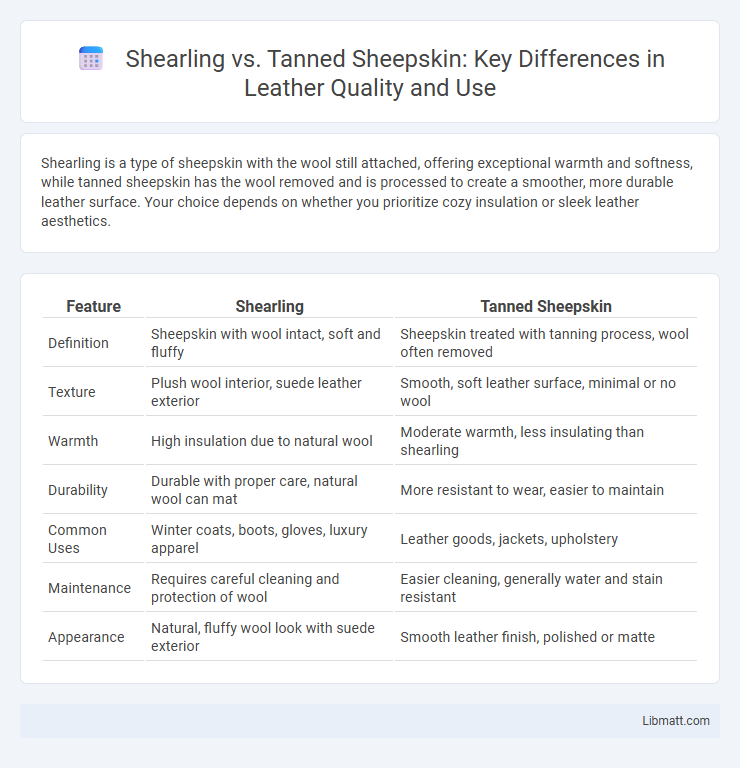Shearling is a type of sheepskin with the wool still attached, offering exceptional warmth and softness, while tanned sheepskin has the wool removed and is processed to create a smoother, more durable leather surface. Your choice depends on whether you prioritize cozy insulation or sleek leather aesthetics.
Table of Comparison
| Feature | Shearling | Tanned Sheepskin |
|---|---|---|
| Definition | Sheepskin with wool intact, soft and fluffy | Sheepskin treated with tanning process, wool often removed |
| Texture | Plush wool interior, suede leather exterior | Smooth, soft leather surface, minimal or no wool |
| Warmth | High insulation due to natural wool | Moderate warmth, less insulating than shearling |
| Durability | Durable with proper care, natural wool can mat | More resistant to wear, easier to maintain |
| Common Uses | Winter coats, boots, gloves, luxury apparel | Leather goods, jackets, upholstery |
| Maintenance | Requires careful cleaning and protection of wool | Easier cleaning, generally water and stain resistant |
| Appearance | Natural, fluffy wool look with suede exterior | Smooth leather finish, polished or matte |
Understanding Shearling and Tanned Sheepskin
Shearling is a natural sheepskin material with the wool still attached, offering a soft, insulating texture ideal for warmth and comfort. Tanned sheepskin undergoes a tanning process that preserves the leather side while typically removing or reducing the wool, giving a smoother, more durable finish. Understanding these differences helps you choose the right material based on whether you prioritize softness and insulation or leather durability and appearance.
How Shearling Is Made
Shearling is made from the hide of a sheep that has been tanned and dressed with the wool still attached, creating a soft, suede-like exterior and a plush wool interior. During the tanning process, the skin is carefully treated to preserve the fleece and enhance durability, resulting in a material both warm and breathable. The quality of shearling depends heavily on the tanning method used, which balances moisture resistance with comfort, making it distinct from fully tanned sheepskin that lacks the natural wool lining.
The Tanning Process for Sheepskin
The tanning process for sheepskin involves transforming raw hides into durable, soft leather by treating them with tannins or chemicals that preserve and enhance their natural qualities. Shearling undergoes a specific tanning technique that keeps the wool intact and soft, maintaining its insulating properties, while tanned sheepskin typically refers to hides treated primarily to enhance the leather surface without preserving the fleece. This tanning method influences the texture, durability, and application of the final product in fashion and upholstery industries.
Key Differences: Shearling vs Tanned Sheepskin
Shearling is a type of sheepskin with the wool still attached, offering natural insulation and softness, while tanned sheepskin is treated to preserve the hide without the wool, resulting in a smooth leather finish. The key difference lies in texture and function: shearling provides warmth and comfort due to the fleece lining, whereas tanned sheepskin offers durability and a sleek appearance suitable for various leather products. Understanding these distinctions helps you choose the right material for warmth or style in footwear, outerwear, and accessories.
Texture and Appearance Comparison
Shearling features a soft, plush wool interior with a suede exterior, offering a luxurious, fluffy texture and a natural, rich appearance. Tanned sheepskin undergoes a tanning process that makes the leather smoother and more uniform, often resulting in a firmer texture and a polished, matte finish. The contrast between shearling's cozy, voluminous fleece and tanned sheepskin's sleek, leather surface defines their distinct tactile and visual appeal.
Durability and Longevity
Shearling, with its wool intact, offers superior insulation and natural breathability, extending the lifespan of your garments through enhanced moisture management. Tanned sheepskin undergoes chemical treatments that improve its resistance to wear and tear, providing a durable, supple finish that withstands daily use. Choosing shearling or tanned sheepskin depends on your preference for natural warmth versus optimized durability and longevity.
Insulation and Comfort Factors
Shearling offers superior insulation by retaining natural wool fibers that trap heat, making it an excellent choice for cold environments. Tanned sheepskin, while durable and moisture-resistant, provides less warmth due to the removal of the fleece during processing. Your comfort benefits most from shearling's plush texture and thermal properties, ideal for maintaining consistent body heat.
Popular Uses in Fashion and Home
Shearling is prized in fashion for its soft, warm texture, often used in luxury coats, boots, and accessories, while tanned sheepskin is favored for durable home furnishings like rugs, throws, and slippers. Both materials offer natural insulation and comfort, with shearling garments providing stylish protection against cold weather. Your choice between shearling and tanned sheepskin depends on whether you prioritize fashion-forward wear or cozy, practical home decor.
Care and Maintenance Tips
Shearling requires gentle cleaning with a specialized shearling conditioner and should be kept dry to maintain its softness and natural oils, while tanned sheepskin benefits from regular brushing to prevent matting and occasional application of leather conditioners to preserve its suppleness. Both materials should be stored in a cool, ventilated area away from direct sunlight to avoid fading and cracking. Avoid machine washing and excessive moisture exposure to ensure durability and longevity of shearling and tanned sheepskin products.
Which Should You Choose?
Shearling offers a luxurious blend of soft wool and supple leather, providing superior warmth and breathability, ideal for cold climates. Tanned sheepskin undergoes chemical treatments that enhance durability and water resistance, making it a practical choice for outdoor use. Your decision hinges on whether you prioritize comfort and natural insulation (shearling) or rugged, weather-resistant performance (tanned sheepskin).
Shearling vs tanned sheepskin Infographic

 libmatt.com
libmatt.com